Jodie Turner-Smith Queen & Slim
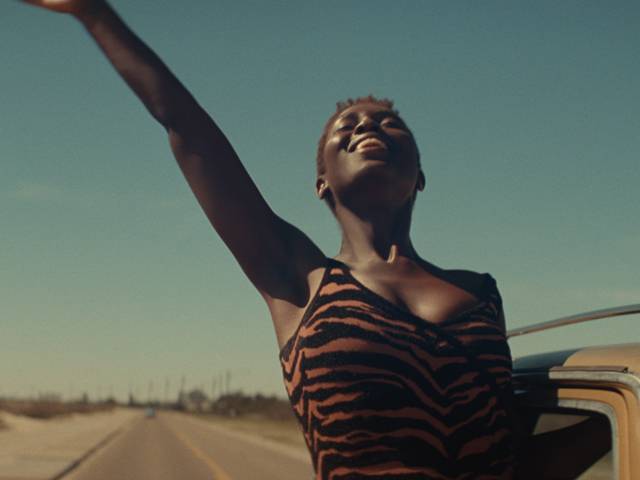
A Couple's First Date Takes An Unexpected Turn
Cast: Daniel Kaluuya, Chloë Sevigny, Bokeem Woodbine, Sturgill Simpson, Indya Moore, Jodie Turner-Smith
Director: Melina Matsoukas
Genre: Drama
Running Time: 132 minutes
Synopsis: From two-time Grammy Award-winning director Melina Matsoukas, the visionary filmmaker behind this generation's most powerful pop-culture experiences, including HBO's Insecure, the Emmy award-winning "Thanksgiving" episode of Netflix's Master of None, and Beyoncé's "Formation," and from trailblazing Emmy-winning writer Lena Waithe (Netflix's Master of None), comes the unflinching new drama, Queen & Slim.
While on a forgettable first date together in Ohio, a Black man (Get Out's Daniel Kaluuya) and a Black woman (Jodie Turner-Smith, in her first starring feature-film role), are pulled over for a minor traffic infraction. The situation escalates, with sudden and tragic results, when the man kills the police officer in self-defense. Terrified and in fear for their lives, the man, a retail employee, and the woman, a criminal defense lawyer, are forced to go on the run. But the incident is captured on video and goes viral, and the couple unwittingly become a symbol of trauma, terror, grief and pain for people across the country.
As they drive, these two unlikely fugitives will discover themselves and each other in the most dire and desperate of circumstances and will forge a deep and powerful love that will reveal their shared humanity and shape the rest of their lives.
Joining a legacy of films, such as Set It Off and Thelma & Louise, Queen & Slim is a powerful, consciousness-raising love story that confronts the staggering human toll of racism and the life-shattering price of violence.
Queen & Slim
Release Date: March 12th, 2020
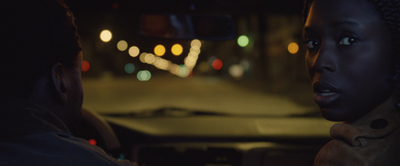 The Backstory
The Backstory
Second City Connection
A Chance Encounter, A New Idea
Set amidst the upheaval of modern-day media-fueled America, Queen & Slim is a searing exploration of the country's current social and political climate through the unfiltered lens of a defiant but life-affirming story of Black love.
The origin of the project was seeded by a chance meeting, when best-selling author James Frey (A Million Little Pieces and novel My Friend Leonard) was introduced to Lena Waithe. Waithe is from Chicago, and Frey had gone to school in Chicago for a year, so they shared that connection. Eventually Frey shared a nascent idea he had with her. Frey's initial idea: A Black man and a Black woman go on a first date. He drives her home when they are pulled over by a police officer. The situation escalates, the cop is killed in self-defense. Rather than report it, the couple goes on the run.
Frey rightfully understood that, whatever iteration the idea took, it would need a deft Black voice to bring it to life. His hope was that the voice would be Waithe, if she were interested. Waithe, an evocative and socially conscious writer, producer and actor, reacted immediately. She knew there was a movie rooted in the idea. Now, she just needed to figure out what it was.
A Love Letter to Black America
Waithe Conjures New Cultural Icons
Waithe, who won an Emmy for writing on the Netflix series Master of None, began work on the screenplay and eventually shared a draft with her producing partner Andrew C. Coles, a former executive at Overbrook Entertainment and Scott Rudin Productions.
Like Waithe, Coles gravitates toward material that's centered around the Black cultural experience, and he knew Waithe was in the midst of crafting a socially relevant snapshot of the contemporary American consciousness. "One of the things that Lena has consistently done throughout her career, whether it's writing, producing or acting, is saying something authentic, saying something timely and saying something that is meaningful to people," Coles says. "One of the things that was so exciting about this project from the beginning was the focus on these two individuals, people who might normally end up as just a headline for several news cycles and build a movie around them. In a lot of ways, Queen & Slim is a love letter to the Black community. It is a way to talk about our humanity and the lives that we live, the people who love us, the families that we have, and how all of that can very conveniently be forgotten when someone is brutalized by the police and becomes a headline."
Waithe would go on to develop the screenplay through her normal workshopping process, defining the characters and defining the story. The film's title, however, was an almost immediate decision. Within the first couple of paragraphs of her screenplay draft, Waithe knew she would call the beautiful and regal female lead Queen and her salt-of-the-earth suitor Slim. "I named her Queen because I think all Black women are Queens," Waithe says. "And Slim is an old-school affectionate term that Black men used to call each other. I wanted to tell a story about two very different Black people who are forced to be in a car together, who ultimately fall in love and around whom the outside world would create their own story and mythology. The story really comes down to the heroes that we create for ourselves to give us hope."
Conversely, most of the people Queen and Slim encounter during their journey are nameless, both on the screen and in the script. Waithe intentionally chose to name them with generic descriptors, e.g. "Large Black Man," "Sheriff," etc. "For me, it was less about the characters' names and more about who they are," Waithe says. "People who are familiar with each other rarely use one another's names in conversation"they just know each other as people. I wanted the audience to get to know the characters as themselves, rather than focusing on what their names are."
It would take Waithe almost 18 months to complete her first draft. Throughout it all, she was simultaneously overseeing her Showtime series The Chi, writing for Master of None and filming her co-starring role in Steven Spielberg's Ready Player One. During the development and writing process, Waithe had mentioned the project to Daniel Kaluuya, whom she knew socially. He was then coming off his Academy Award® nomination for Jordan Peele's Get Out and was immediately intrigued. "Initially, Lena mentioned to me that she was working on a Bonnie and Clyde story," Daniel Kaluuya says. "I thought, 'Lena's voice on that kind of narrative is definitely something I'd watch.' A couple months later, she told me the premise of the film over dinner, and I remember being excited from there on out. I knew I wanted to be a part of it."
Waithe knew Kaluuya would be an exciting choice to play Slim, but at the time she didn't have a director committed to the film, and she wanted whoever that was to be involved in any casting decision. Luckily, Waithe had already been in early discussions with her top choice to direct Queen & Slim.
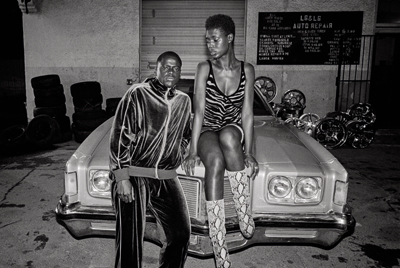 A Visionary Filmmaker
A Visionary FilmmakerMelina Matsoukas Takes the Helm
When it came to consider directors for the project, Waithe could not envision anyone other than Melina Matsoukas at the helm. Matsoukas and Waithe share a deep commitment to showcase the multicultural perspective in their work, and to create art that is more inclusive of people of color, women and the LGBTQIA community, and Matsoukas undoubtedly had the artistic acuity, the distinct point of view and the directing chops that the material demanded.
A longtime creative collaborator with Beyoncé, Matsoukas directed the groundbreaking video "Formation," from the pop icon's 2016 album Lemonade, as well as music videos for a who's who of recording artists in the music industry. She had also recently directed and executive produced the HBO series Insecure starring Issa Rae.
Waithe had first met Matsoukas on the set of Master of None, when Matsoukas directed Waithe's deeply personal "Thanksgiving" episode"the episode that would go on to earn Waithe her historic Emmy Award as the first Black woman in history to win for comedy writing. They hit it off immediately. "Lena trusted me in ways that I had never actually experienced before, so it was a tremendous working experience," Matsoukas says. "I call her my 'work soul sister.'" Waithe felt the same way. "Melina and I have a beautiful partnership," Waithe says. "We have great chemistry, and it happened very organically. It was like we were sisters immediately."
At the time they met, Matsoukas was searching for the right project to be her first feature film, and Waithe was working on the screenplay for Queen & Slim, which would be her first film as a writer as well.
Matsoukas's producing partner, Michelle Knudsen, read the first draft of Waithe's Queen & Slim script and was floored. As Matsoukas's potential first film, it ticked all the boxes. "Queen & Slim is contemporary and it's provocative," Knudsen says. "It doesn't pull any punches. It has this incredible mix of lightness, love and kinetic energy while also dealing with very difficult subject matter. But it is very honest, and I immediately thought that there was something about the way it was written that just felt like a perfect match for the visual work that Melina loves to do. She loves to do things that are powerful and that speak to Black America. It's a classic cinematic story in the vein of a Bonnie and Clyde or a Thelma & Louise, but it's also such an American story: the road movie across America. Now, in this moment, that feels so relevant and so important. This is meant to be a window into this couple's journey through America. It becomes an exploration of the American landscape, both physical and metaphorical."
Matsoukas herself was motivated by the intent and energy behind Waithe's script. "My passion for any project will always come from the material, and Lena's script did not disappoint," Matsoukas says. "Reading that last page, I knew the film could be revolutionary, and I knew I wanted to be the one who would bring this story to life. I couldn't have chosen a better partner to go on this journey with. Queen & Slim is the first feature film for us both, so I knew it would be special. I like to do things that shift and create a dialogue and challenge the way people think and maybe lead to a change in the world in some way. I've tried to do that with my previous work in music videos, television and commercials. I focus on projects that I'm passionate about, that speak to my values as a person, first and foremost, and then as an artist who can entertain and inform."
Waithe was thrilled to join forces with Matsoukas in bringing this landmark film to life. "She's a ball of fire and had such a unique vision for Queen & Slim," Waithe says. "She took everything very seriously and was passionate about every detail. She made sure that every shot, look and moment was iconic, and she brought the words to life in a way that only she could." She never doubted that Matsoukas had been the right filmmaker to bring this story into the world. "I felt very comfortable with the story in Melina's hands," Waithe says. "She's always exceeded my expectations. To me, we're like Dwyane Wade and LeBron James. I toss her the ball up and she knows what to do with it."
By then the project had caught the attention of veteran entertainment executive Brad Weston and Pamela Abdy, who had recently partnered together to found Makeready, an independent studio with a focus to develop, finance, and produce talent-driven projects exactly like Queen & Slim.
"Queen & Slim is a powerful, beautiful and authentic film about culture and systemic problems in our country," Weston says. "When Pam and I launched Makeready, we worked at defining the type of content that we wanted to make and be known for. Queen & Slim became our first film. It felt like the perfect representation of what we wanted our company to stand for. Sadly, this story is as relevant as any idea could be, and our hope is that the authenticity and realness will stimulate conversations and become part of the cultural narrative."
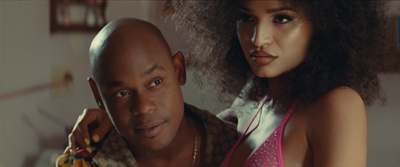 Only One Slim
Only One Slim Daniel Kaluuya Says, "Yes"
With Melina Matsoukas on board, Lena Waithe and the producing team turned their focus to begin the process of casting for the title roles.
Waithe envisioned Slim as a hard-working, church-going everyman whose aspirations aren't grand. He's an ordinary man living an ordinary life until something explosive and profound occurs changing him and his worldview. He is everything that Queen is not.
Oscar® nominee Daniel Kaluuya had already expressed interest in the role, and Matsoukas knew very quickly after meeting him that he was her Slim. "From the beginning, I was really conscious of how Slim would be portrayed," Matsoukas says. "Even in his most vulnerable moments at the beginning of the film, he is still strong and very much a man that you would respect. Daniel brings all these qualities to life in ways that I couldn't have imagined. I always say he's the Denzel Washington, the Sidney Poitier, the Paul Robeson of our generation. How he completely embodies this character, which is so different from any other role I've seen him play on screen, is a testament to how great an actor he is."
Like Matsoukas and Waithe, Kaluuya strives to make films that speak to and for those whose voices are not fully represented, including the global box-office hit Black Panther. As a Black man and an artist, Kaluuya found that this story resonated with him on an intimate level and was a powerful cultural touchstone with beautifully crafted characters. "Audiences rarely see films from the perspective that Queen & Slim is from," Kaluuya says. "Not in terms of race, but in terms of mentality. I want to make content for people that don't feel seen, and this story felt radical in that way."
Kaluuya joined the project as both its male lead and as an executive producer. "I came on as an executive producer because I wanted to help introduce this story to the world," Kaluuya says. "I wanted to be part of the conversation and to collaborate with the filmmaking team about protecting the message of this film." And he was inspired by the vision and commitment of his director. "Melina brought swag to this story," Kaluuya says with a smile. "She put a great amount of care, love and specificity into every tiny detail of this film."
With Slim on board, though, they now needed to find their Queen.
The Quest for Queen
As news of the film buzzed around the industry, a number of well-known actresses expressed interest, but from the beginning, Melina Matsoukas and Lena Waithe knew they wanted to cast a newcomer for the role of the fiercely independent and educated Queen, a complex and self-sufficient woman who carries the baggage of a troubled and checkered past.
An exacting criminal lawyer who has seen firsthand the effects of the judicial system, especially on young Black men and women, Queen is propelled by the desire to leave her mark on the world. That singular noble pursuit of justice, though, is closely intertwined with Queen's traumatic past, and the insurmountable emotional walls she's erected around herself is her mark of self-preservation.
Ultimately, the role would go to Jodie Turner-Smith. Matsoukas had previously worked with Turner-Smith, then a fledgling actor, years before on a commercial. Turner-Smith had since gone on to roles in two series, Nightflyers and The Last Ship, and had worked in a handful of independent films, all showcasing a deep well of talent conveyed through expressive eyes and graceful movements. Matsoukas remembered her as she viewed an audition tape. She liked what she saw and invited her in for a second audition.
"Jodie came into that audition, and she killed it," says Matsoukas. "I was really excited about her, and her performance was just tremendous. We all were really impressed and confident that we found our Queen." Turner-Smith felt she intuitively understood Queen. "Queen is a very intelligent, well-educated woman," Turner-Smith says. "She has a commitment to excellence, which is what makes her so tough on herself and other people. It's not that she's a mean person, she just has high standards. Queen is a survivor. She's created a successful life for herself despite everything she's been through."
The moment Kaluuya and Turner-Smith tested together on camera, the filmmakers knew the chemistry was there. There was a tightly calibrated, slow burn to the pair that would sustain an audience through their journey of self-discovery and love amidst trauma and fear.
For Turner-Smith, the combination of Waithe's insightful snapshot of the contemporary Black experience coupled with Matsoukas's singular and visually striking style of filmmaking was too irresistible to ignore. "Melina had such an incredibly specific aesthetic and vision for this film," Turner-Smith says. "I was thrilled to be part of a project that was directed and written by two dynamic, interesting and talented Black female voices. Lena's writing is impeccable, and Melina's direction added a different color, depth and intensity to this film that I don't think has been seen before."
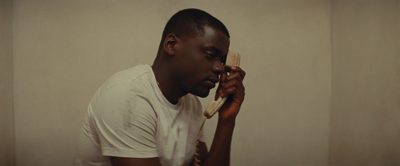 Violence, Racism and Love
Violence, Racism and Love Truth and Meaning in Queen & Slim
At times a study of race, gender and inclusiveness in America, Queen & Slim is also a soulful love story forged from that explosive cultural landscape. "This film uses the horrible situation that Queen and Slim are put in to show the power of community and the need to stand up for oneself," producer Brad Weston says. "The racism and police brutality that this film dives into is heartbreaking, but it ultimately shows that love prevails and humanity wins."
In a split second, the lives of two law-abiding citizens change and they are forever intertwined. Queen, who has been shot and wounded by the police officer, is at her most vulnerable as she fights to stay in control. Slim, who shot and killed the police officer in self-defense after the officer shot Queen, is numb with the realization he unwittingly took a life. Both are plunged into a chaotic and dire situation they can't talk their way out of. They flee the scene to regroup, knowing to stay means certain retribution from the police.
"A lot of the material in this story is heavy and emotional," Turner-Smith says. "It touches on how Queen and Slim process trauma and is infused with paranoia because the two of them are constantly on the run."
The filmmakers acknowledge that there are no easy answers or solutions to the complicated and thought-provoking situations presented in the film. "As artists, Lena and Melina are not heavy-handed," says producer Andrew C. Coles. "They are not going to shove a message down an audience's throat, but they are going to ask hard questions. They are going to create a provocative scenario that, we hope, creates dialogue."
As Waithe developed the screenplay and her two lead characters, she drew inspiration from 1960s civil rights icons Malcolm X and Martin Luther King, Jr. "In the beginning, Queen was Malcolm X and Slim was Martin Luther King," Waithe says, "and by the end of the story, they switch places." Like Spike Lee and his seminal classic Do the Right Thing, Waithe was striving to encourage a discourse on race relations in America with Queen & Slim, in a multilayered story that also speaks to love, hate, fear and ultimately the human condition. "I want audiences to determine for themselves whether or not they think Queen and Slim are heroes," Waithe says. "People will have different takes on it, and that's what's great about art. Rather than audiences looking to the artist for the answer, I prefer to let the art speak for itself, allowing the audience to look to themselves for the answer."
Several times over the course of the eight-week film shoot, the filmmakers, cast and crew would arrive on set to hear another news story chronicling an incident or legal decision involving the shooting of a Black person by police. It served as a constant reminder of the importance and timeliness of the story they were telling, and it reinforced their hope that the film they were making would have an impact and jump-start a fresh round of conversation for change. "Queen and Slim don't see themselves as heroes because they didn't ask to be put in the situation that they're in," producer Weston says. "They simply take destiny into their own hands and make proactive decisions to fight for what they stand for."
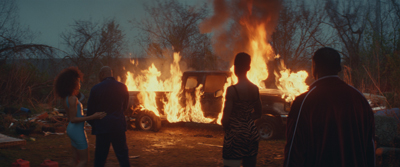 The Characters
The Characters
Queen and Slim
Jodie Turner-Smith and Daniel Kaluuya
For Slim, taking a life, no matter the circumstances has a profound effect on him. He's now a hunted man who no longer has the luxury of a simple life. The aftermath of the shooting forces him to take the reins of his life while grappling with being inserted into the powder keg of a national issue. "I can understand why people would see Queen and Slim as heroic," Daniel Kaluuya says. "But at the same time, I can see the perspective that they are just humans fighting for their lives. They're complex, flawed and make mistakes, just like everyone else."
Just as important, Queen and Slim also continue to evolve as they share more of themselves with each other and everyone they meet. Slim has become a man who he never imagined that he would be, just as Queen has become a woman whom she never imagined that she would be.
"Slim begins this film pleading for his life to the officer," Kaluuya says. "He continues to change throughout the film by losing his fear. In the beginning, he's quiet and unassertive. His confidence and the way he carries himself evolve as the story progresses. He's pushed into spaces he's never been before in order to survive."
Adds Jodie Turner-Smith: "I don't look at them as heroes as much as I look at them as accidental activists. They were thrust into this situation purely by the fight-or-flight urge that happens when you face death. They responded to a horrible circumstance in the best way that they knew how, which is not necessarily heroic, but it's brave."
As Queen and Slim's journey unfurls over hundreds of miles together, the pair begin to shed their inhibitions and get to know each other and soon begin to affect one another. Their similarities, once concealed, are revealed. "Queen isn't comfortable being vulnerable, so when she opens up to Slim, it's quite a breakthrough moment," Kaluuya says. "He doesn't judge her, and it's a massive turning point for their dynamic, because she realizes that expressing herself to him is a safe space for her. Both Queen and Slim assume that they can't articulate their psyche, fears or guilt to others out of fear of being judged. Slim allows Queen the space to do that, which serves as the foundation of a great relationship."
When we first meet Queen, Turner-Smith explains that, she's a woman who isn't comfortable with revealing her true self to anyone. "Queen starts out this story with walls around her," Turner-Smith says. "Slim helps her open up and let her guard down because she's afraid, and she confides in him about how she truly feels. The dancing scene between Queen and Slim is a beautiful moment and a great metaphor for this. When you're dancing, someone leads, and someone allows themselves to be led. Queen not only allows Slim to lead her in dance but allows him to lead them through their journey."
Queen and Slim are not the real names of the characters. It isn't until the end of the film, in fact, that the audience learns their true names. That was a deliberate and symbolic creative choice. "That was a very poignant decision that Lena made," says producer Pamela Abdy. "It makes a statement about the fact that we don't stop to pay attention to people or their names when it actually matters."
Over the course of seven days, Queen and Slim's journey begins in Ohio and then snakes it way south to Kentucky, Tennessee, Louisiana, Alabama and finally to the Florida Keys. With each mile, the unwitting renegades encounter people who bear witness to their journey/flight. Whether those people agree or disagree with Queen and Slim's actions, they each glimpse a bit of the humanity behind the man and woman in the news reports.
Uncle Earl
Bokeem Woodbine
On their drive south, Queen and Slim take temporary refuge at the New Orleans home of Queen's estranged uncle, Earl, portrayed by Bokeem Woodbine, in the Tremé neighborhood. Woodbine is a veteran actor whose early roles in the late 1990s made him a household name in the Black community. It was his memorable portrayals in films such as Jason's Lyric and Dead Presidents that inspired Melina Matsoukas when she thought about casting for the role of Earl, the tortured vet who tries to make amends and help his niece.
The director knew Woodbine could bring the character to life, and Woodbine was riveted by the film's vision and ambitions. "When I learned about this story, I realized it was a project that I had to be a part of," Woodbine says. "I thought it was not only innovative, but revolutionary. It is told from an iconoclastic perspective, which really resonated with me. I think there are many things that can be changed not only in our community, but in the arts, which is what makes this particular story extremely special. It's a beautiful story that illuminates what can happen when power goes unchecked."
There's a strained underlying tension when Queen and Slim arrive on Earl's doorstep. Queen's history with her uncle is complicated, and Earl understands that she truly must be in a bad place if she's willing to show up unannounced asking for his help. "Queen has grown distant from him," Woodbine says. "It hurts Uncle Earl to know that she wants nothing to do with him, but he also understands why she has distanced herself from him, and he's proud of her accomplishments. She's both a superhero and a source of shame to him."
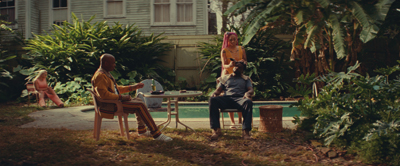 Mrs. and Mr. Shepherd
Mrs. and Mr. Shepherd
Chloë Sevigny and Flea
Oscar-nominated actress Chloë Sevigny and Flea, the actor and bassist for the Red Hot Chili Peppers, portray a married couple, aptly named the Shepherds, who give refuge to Queen and Slim as they arrive on the steps of Shepherds' genteel Savannah, Georgia, home. A military buddy of Uncle Earl's, Mr. Shepherd is willing to help direct the fugitives on the final leg of their journey. But Mrs. Shepherd, while agreeing to go along with her husband, is clearly not onboard with the idea of helping them. The tension between them reaches a breaking point when the police arrive, and Mr. Shepherd directs Queen and Slim to a hiding place in the home to evade them.
Melina Matsoukas, a longtime fan of Sevigny, had always envisioned the actress for the conservative Mrs. Shepherd, and casting director Carmen Cuba suggested Flea to play Mr. Shepherd. The result is a depiction of a marriage under extreme strain, a strain expressed almost wordlessly between the two actors.
Police Officer Reed
Sturgill Simpson
Grammy Award-winning country recording artist Sturgill Simpson stars as Officer Reed, the Cleveland police officer whose decision to pull over Queen and Slim for an alleged traffic violation sets the events of the film in motion. Simpson, who's best known for his genre-bending country music career, has recently transitioned to acting with roles in Jim Jarmusch's The Dead Don't Die and the CBS All Access television series One Dollar. He was drawn to the vision and intent behind Queen & Slim. "I was very familiar with Lena and Melina's work before we began filming, so I knew it was going to be a very beautiful film," Simpson says. "It's a very real and significant story to talk about. Although I don't have any formal acting training, I've always loved film and had reached a point in my music career where I was feeling quite comfortable. I wanted to do something outside my comfort zone, and when I started acting, it challenged me in ways that I hadn't been challenged in a long time. It was very gratifying."
Goddess and Naomi
Indya Moore and Melanie Halfkenny
When Queen and Slim arrive at the home of Queen's Uncle Earl, it becomes clear that Earl is an old-school player surrounded by a coterie of strippers and sex workers including Goddess, played by Indya Moore, and Naomi portrayed by social media star Melanie Halfkenny, who makes her feature film debut in Queen & Slim.
For Moore, the transgender actress/activist best known for her trailblazing role in Ryan Murphy's award-winning FX series Pose, the role of Goddess, the nurturing sex worker, was emotional and transformative. "Before I got this role, there had never been a trans person in a major studio film," Moore says. "To take on the role of someone who takes care of and loves others, and for that role to have nothing to do with gender, was really powerful. The trans community rarely has the opportunity to tell stories, so it was very special to me."
"Goddess is a survivor," she continues. "She is a sex worker, but she also has the support of her family, which helps her feel confident and secure about having such a stigmatized occupation. Similar characters are often demonized, but Goddess has very humanizing moments in this story, which I think is a special and important way to portray her."
For the character of Naomi, Lena Waithe came across Halfkenny on Instagram and was mesmerized by her bold imagery. Halfkenny, a striking woman with rainbow-hued braids that cascaded down her back, presented a sexy, empowered persona that commanded attention.
Halfkenny, who has never acted beyond the occasional music video, didn't know what to expect when she received a direct message from casting director Carmen Cuba saying Matsoukas and Waithe were interested in casting her in their movie. The Atlanta-based social media standout seized the opportunity and didn't look back.
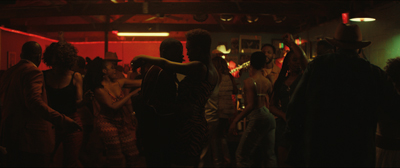 Junior
Junior
Jahi Di'Allo Winston
Once the pair make their way to Tallahassee, Florida, where their car breaks down, Queen and Slim meet a young Black man, Junior, played by Jahi Di'allo Winston (Netflix's Everything Sucks!, The Upside). Junior's father, who's fixing the car, sees the danger of what Queen and Slim's actions have ignited in the Black community and the country at large, but Junior, inspired by the stories he's heard of Queen and Slim, perceives them as bold, fearless outlaws. In his eyes Queen and Slim are heroes who have done what most young Black people wouldn't dare to do. The actions he later takes, clearly motivated by their example, are among the most shocking in the entire narrative.
The Locations
Icy Cleveland, Lush New Orleans
Queen & Slim Hit the Road
While the production was based in the New Orleans area for the majority of filming, cast and crew began principal photography in Cleveland, Ohio, where the film's first scenes are set, and where Queen and Slim have their fatal encounter with Officer Reed. The production began in January 2019 with nighttime exterior scenes, shot amidst frigid temperatures, bottoming out below zero, during a polar vortex that had descended upon the Midwest.
The production's tempo ebbed and flowed throughout each night as cast and crew took breaks to warm up. To all, the experience was worth it and would prepare them all for the ride of a lifetime. "The weather didn't make things easy," Lena Waithe says. "But in the end, this is a road-trip movie, so being out there in the real world rather than on a soundstage made it feel much more authentic and real. I think the real environments that we were in make the scenes much stronger."
Once filming began in Louisiana, the story's road-trip aspect would take the production crew throughout the Crescent City and beyond the city limits to small towns and roadways, sometimes requiring hours of travel. It's a testament to the state's versatile landscape that it was able to satisfy the locational demands of the script which has Queen and Slim traveling from Ohio through Kentucky, Tennessee, Louisiana, Alabama, Georgia and Florida.
Executive producer Pamela Hirsch, a veteran filmmaker who has overseen the production of such critically acclaimed films as Miles Ahead and Can You Ever Forgive Me?, guided the production through dozens of diverse locations during the eight-week shoot. For Hirsch, the continuous dance of marrying the creative and practical demands of a road-trip-focused project would test her at every turn. "One of the biggest challenges of Queen & Slim was maintaining the authenticity of the road-trip aspect of the story," Hirsch says. "It was important to Melina that we film all the car-based scenes in a moving vehicle to capture that realism. This required filming multiple locations each day and the labor-intensive process of backtracking to re-shoot exterior car work to match the interiors. Sometimes that meant returning to locations to capture similar lighting and landscapes. Ultimately, it was very gratifying to see the fruits of our labor. These incredible moments between our characters and their journey plays out as it should. It's something I'm very proud of." In all their endeavors, Melina Matsoukas and her fellow filmmakers were joined by a top-flight team of cinematic artists, including director of photography Tat Radcliffe, production designer Karen Murphy and costume designer Shiona L. Turini.
The Cinematography
Light and Truth
The Singular Cinematography of Queen & Slim
Director of photography Tat Radcliffe cut his teeth shooting music videos with the likes of Nine Inch Nails and Depeche Mode in the 1990s. He and Melina Matsoukas shared a desire to maintain an unconventional visual aesthetic reminiscent of the lighting and framing in director Hype Williams' cult classic Belly.
Filming in Louisiana, particularly in New Orleans, offered Radcliffe unlimited possibilities when it came to his lighting plan amidst a kaleidoscope of color, textures and architecture. "I like to use available light as much as possible," Tat Radcliffe says, "and it was more a question of choosing the right time of day and adding an accent or two to what was an enchanting city full of life and texture. It was an absolute pleasure to shoot in New Orleans."
The British cinematographer is equally comfortable operating the camera, which made for an easy partnership with Matsoukas for seamless tweaks to camera movements or discovering new dynamic shots in the moment. Matsoukas's early background in photography is a major influence and reference point for her distinguished catalogue of work and continues with every new project. Her desire to shoot her first feature on film was an integral part to making her feature film directorial debut. "I always try to shoot on film," Matsoukas says. "It just has a soul, it has a texture that you can't duplicate."
Radcliffe was all in favor of that decision. "The beauty of celluloid is that it can deal with the subtle variations of saturated colors which we wanted to incorporate into the lighting design," Radcliffe says. "Film can be so wonderful for capturing the variegated subtleties of skin tone, and it helped to create a stylish aura around Jodie and Daniel."
Together Matsoukas and Radcliffe would strive to craft a singular approach to capture the grittiness of life and to imbue it with a scenic quality. "A lot of my choices as a director are based in authenticity," Matsoukas says. "I love to capture real locations and people but then weave in a bit of style to it with a mixed light palette. I want the audience to be able to see the grittiness of life but make it feel natural and picturesque, utilizing natural light in really beautiful ways."
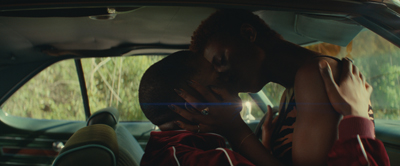 The Production Design
The Production Design
The Divine Is in the Details
The Deep Layers of Queen & Slim
Melina Matsoukas is a very detail-oriented filmmaker and found a like-minded spirit in production designer Karen Murphy, whose expertise and specific approach to her craft made for a true partnership between them.
Inspired and informed by Matsoukas's take on the material, Murphy was able to transform the prosaic into something meaningful and then illustrate it with captivating visual references. Together Murphy and Matsoukas created a comprehensive "look book," a visual blueprint that Matsoukas shared with her team as filming began so they could see her vision presented with vibrant and compelling imagery. "I always want to be involved in every aspect of my projects and Karen understood that and embraced it with me," Matsoukas says. "We would talk endlessly and brainstorm to determine the best design options for the film. I love doing that with somebody who cares and who is a true artist in their world, and Karen Murphy is very much that. She pulled amazing photography of interiors, architecture, different cars and landscapes that we could talk through to tell the story and see what felt perfect for each location and each character. She is tremendous."
Perhaps the most dramatic and significant example of their efforts is illustrated with Murphy's execution of Matsoukas's very specific vision for creating the haven that Uncle Earl and his makeshift family provide for Queen and Slim. The beautifully decayed grandeur of Queen's family home is Matsoukas's favorite set piece in the film.
"The Uncle Earl's house set is one of those beautiful old homes in New Orleans which Karen totally redid," Matsoukas says. "We pulled a bunch of references of rooms with peeling wallpaper, and different colors and different kinds of furniture. She redesigned the whole space, even aging it down by repainting the inside and out to reflect the decades of history and influences from the ʼ50s when Earl's mother, Queen's grandmother, lived there to Earl's heyday in the ʼ80s and ʼ90s. Now, Earl's living with Goddess and Naomi and the other women there. That collective history is all layered throughout the house. It's just the perfect combination of different cultures and characters that have come and gone through all of these rooms."
Naturally, most of the scenes in a road-trip film occur in a car, and theirs needed to feel as iconic as the characters themselves. So, while Queen and Slim begin their journey in Slim's humble early-model white Honda with the words "God First" declared proudly on his license plates, they switch cars at Uncle Earl's, continuing their journey in Earl's beloved turquoise 1973 Pontiac Catalina, his parting gift to the pair.
The Costume Design
Transformation and Revelation
History and Meaning in Queen & Slim's Wardrobe
Shiona L. Turini, a noted fashion stylist, editor and social influencer who recently transitioned into costume design, has previously worked with Melina Matsoukas on Beyoncé's "Formation" music video and HBO's Issa Rae series Insecure among others. The fashion insider would bring a fashion-forward aesthetic to Matsoukas's dynamic storytelling with a heavily curated mix of high-end, budget and custom pieces.
From the likes of Louis Vuitton, Gucci, Pyer Moss and Harlem-based design legend Dapper Dan"whose looks for Bokeem Woodbine's Uncle Earl pack a photographic punch, especially when coupled with the flashy stripper garb of Earl's coterie of women"Turini layered in added dimension to each of the film's characters.
The wardrobe in the film also reflects decades of references to African-American cultural touchstones. Early in the process, armed with thorough research that included period and contemporary imagery, Turini added to Matsoukas's expanding assemblage of photographic references. The shorthand she shared with Matsoukas proved to be invaluable as they fine-tuned the approach to the film's costume design story.
"I love the idea of a formidable love story featuring a woman I relate to," Turini says. "As a Black woman, there was something very magical about being a part of a female-led filmmaking team. Melina and I have collaborated on a number of projects, so I know the way she works and, more importantly, I know her taste. Regardless, I armed myself with a plethora of options that would bring the story alive as we began to create characters and clothing choices that helped Melina build this narrative."
Central to the costume-design story of the film is the transformation that Queen and Slim undergo over the course of their journey. It symbolizes each character's emotional evolution and is punctuated by the time the duo spend with Uncle Earl, Goddess and Naomi at Uncle Earl's home. "Melina is such a visionary," producer Pamela Abdy says. "Every detail in Melina's work has specificity. There wasn't a detail that she didn't weigh in on, down to every fabric choice, every location, every hairstyle. In her artistry, her vision and her ideas about the world, she's truly one of the greats."
Queen
When we first meet Queen, she is in full boss-lady mode, donning an all-white ensemble accented with a suede camel trench coat and worn with a crown of flowing braids. As her journey progresses, she starts shedding her armor and taps into a newfound freedom reflected in her leopard minidress, boots and shorn close-cropped hair.
For Jodie Turner-Smith, Turini had dialed in to her character's style effortlessly. "Shiona has such an elegant style," Turner-Smith says. "Queen is very fabulous and Shiona brought that element into her stylistic choices. She's great at creating the image of a strong and powerful Black woman."
Slim
Daniel Kaluuya's everyman Slim dons an uninspiring ensemble of rumpled Dickies pants, a thermal shirt and a well-worn Carhartt jacket for his first date with Queen. The challenge for Turini was to retain some interest in that ill-advised outfit with fabric and color selections. Slim's wardrobe after his visit to Uncle Earl's evolves into an upmarket velour Pyer Moss tracksuit, which represents Slim's burgeoning metamorphosis into a bolder version of himself.
Makeup, Hair And Music
Bold New Artists
Fresh Creative Takes
Rounding out the film's creative team are a trio of exceptional artists, each unique and masterful in their fields. Melina Matsoukas always has an eye toward up-and-coming and well-established talent, and so she invited a crew whose work she admired to join the film. These included makeup designer Ma Kalaadevi Ananda (Widows, Can You Ever Forgive Me?), hair stylist Brian Badie (True Detective, White Boy Rick) and composer Devonté Hynes aka Blood Orange. In each case, Matsoukas presented every creative on her team with an opportunity to shine and to bring their best to the collective table. That spirit of excellence and collaboration is reflected in every frame of Queen & Slim. Rounding out the film's creative team are a trio of exceptional artists, each unique and masterful in their fields. Melina Matsoukas always has an eye toward up-and-coming and well-established talent, and so she invited a crew whose work she admired to join the film. These artists included makeup designer MA Kalaadevi Ananda (Widows, Can You Ever Forgive Me?), hair stylist Brian Badie (True Detective, White Boy Rick) and composer Devonté Hynes aka Blood Orange. In each case, Matsoukas presented every creative on her team with an opportunity to shine and to bring their best to the collective table. That spirit of excellence and collaboration is reflected in every frame of Queen & Slim.
In addition, Matsoukas and Lena Waithe executive produced the film's powerful soundtrack with Motown Records President Ethiopia Habtemariam. Together, they created a soundtrack that unfolds like a road trip, mirroring the physical, emotional and spiritual journey that the lead characters take in the film.
"I wanted the soundtrack for Queen & Slim to showcase the historical evolution of Black music, from its roots in blues and soul, to modern bounce, hip hop and R&B - much like we used to see in film soundtracks in the 90s," Matsoukas says. "We partnered with Motown because of their legacy within Black music. I am honored to have worked beside Ethiopia and cannot wait for audiences to hear what each artist has created."
The music in the film serves as an additional voice and showcases the range of talent across Black artists with a compelling blend of genres. The 17-song soundtrack features new tracks by Ms. Lauryn Hill, Megan Thee Stallion, Lil Baby, Vince Staples featuring 6lack X Mereba, Tiana Major 9 & EARTHGANG, Coast Contra featuring BJ The Chicago Kid and Syd, plus classic songs by Roy Ayers, Bilal, Mike Jones and others. Blood Orange, who composed the score, is also featured on the soundtrack.
Universal Pictures and Makeready present, in association with 3BlackDot and Bron Creative, a Makeready/De La Revolución/Hillman Grad/3BlackDot production. Daniel Kaluuya and Jodie Turner-Smith in Queen & Slim. Starring Bokeem Woodbine, Chloë Sevigny, Flea, Sturgill Simpson, Indya Moore. Casting by Carmen Cuba. The music supervisor is Kier Lehman and the score is by Devonté Hynes. The costume designer is Shiona L. Turini and the editor is Pete Beaudreau. The film's production designer is Karen Murphy and the director of photography is Tat Radcliffe, BSC. The executive producers are Pamela Hirsch, Daniel Kaluuya, Aaron L. Gilbert, Jason Cloth, Reginald Cash, Angelo Pullen, David Krintzman, Guymon Casady. Queen & Slim is produced by James Frey, Lena Waithe, p.g.a., Melina Matsoukas, p.g.a., Michelle Knudsen, p.g.a., Andrew C. Coles, Brad Weston, Pamela Abdy, p.g.a. The story is by James Frey and Lena Waithe, and the screenplay is by Lena Waithe. Queen & Slim is directed by Melina Matsoukas.
Queen & Slim
Release Date: March 12th, 2020
MORE





